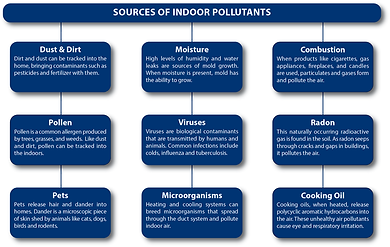



Breathe Cleaner Air with Bio-Shock's Indoor Air Quality Solutions
🌿 Poor indoor air quality (IAQ) can impact your health, comfort, and overall well-being. Bio-Shock provides comprehensive IAQ assessments, helping you identify hidden pollutants and allergens in your environment. Our expert team uses cutting-edge technology to pinpoint the source of air quality issues and offers solutions that ensure a healthier, cleaner living or working space.
Improving Indoor Air Quality Reduces Airborne and Surface Contaminants
💨 At Bio-Shock, we are the experts in improving indoor air quality, reducing airborne and surface contaminants, and pathogens quickly and effectively. As a homeowner or business owner, you want to ensure that the people in your space are safe from particulates, airborne bacteria, viruses, mold spores, and odor. We specialize in creating healthy spaces and promoting wellness within those spaces.
What We Assess: Key Pollutants and Contaminants
🔬 Bio-Shock evaluates a wide range of indoor air pollutants, ensuring a thorough analysis of your environment:
Particulate Matter
🌫️ Dust, pollen, pet dander, and other particles suspended in your indoor air that can aggravate allergies and respiratory conditions.
Volatile Organic Compounds (VOCs)
🧴 Harmful gases released by paints, cleaning products, and household items that can contribute to headaches, fatigue, and other health issues.
Carbon Dioxide (CO2)
💨 High CO2 levels indicating poor ventilation, leading to reduced cognitive function, energy levels, and overall comfort.
Formaldehyde
⚠️ Found in building materials, formaldehyde can irritate the eyes, nose, and throat and cause long-term health risks.
Mold Spores
🍄 Mold growth often hidden behind walls or in damp spaces can release spores that negatively affect air quality and health.
Carbon Monoxide (CO)
🚨 A colorless, odorless gas that’s a silent threat to your health. We ensure your air is free from this dangerous pollutant.
Who Is at Risk from Harmful Effects of Poor Indoor Air?
👨👩👧👦 Everyone is at risk of exposure to indoor contaminants. However, those who spend more time indoors or have compromised immune systems are particularly vulnerable. Medical researchers believe that poor indoor air quality can even affect an unborn fetus, leading to issues like oxidative stress and insulin resistance, which have been linked to fertility problems.
Poor IAQ is also a major trigger for asthma and allergies, particularly in children. With more time spent indoors, the importance of maintaining clean indoor air is becoming even more critical.
Why IAQ Matters
🏠 Health and Comfort: Poor air quality can lead to allergies, asthma, fatigue, headaches, and difficulty concentrating.
💸 Property Value: Homes or businesses with chronic air quality issues can see reduced property values. A thorough IAQ assessment provides the steps needed to resolve these issues.
Comprehensive IAQ Solutions for Every Property
🏢 Whether you’re in a residential, commercial, or industrial property, Bio-Shock provides tailored IAQ assessments to address the unique challenges each space presents. We also offer long-term air quality monitoring, MERV 13 air filtration systems, and IAQ certification programs. Our solutions are ideal for:
-
Homes 🏠
-
Offices 🏢
-
Schools 🏫
-
Hospitals 🏥
-
Industrial Facilities 🏭
Our Process: Thorough, Professional, and Guaranteed
🔍 Step 1: Comprehensive Testing
We use advanced instruments to measure particulate levels, VOCs, CO2, formaldehyde, and more. Our testing ensures no pollutant goes unnoticed.
🔧 Step 2: Expert Evaluation
Our team analyzes the data, identifying sources of pollutants and areas of concern. We provide clear, actionable insights to improve your IAQ.
🛠️ Step 3: Solutions and Recommendations
We recommend effective solutions to reduce or eliminate indoor pollutants, such as air purifiers, filtration systems, and improvements to ventilation and insulation.
Pricing for IAQ Assessments
💰 Flat Rate Starting at $79 for a basic IAQ test, covering temperature, relative humidity (RH), dew point, TVOCs, formaldehyde, particle counts, and CO2.
-
Note: Pricing may increase based on property size or special requests. Larger homes or commercial properties may incur higher rates.
-
Customized Packages: For more complex IAQ issues, we provide tailored pricing based on the specifics of your property and the assessment scope.
Ready to Improve Your Indoor Air Quality?
📞 Bio-Shock offers fast, reliable IAQ assessments to help you breathe easier. Contact us today for a free estimate and take the first step toward a healthier, cleaner indoor environment.





